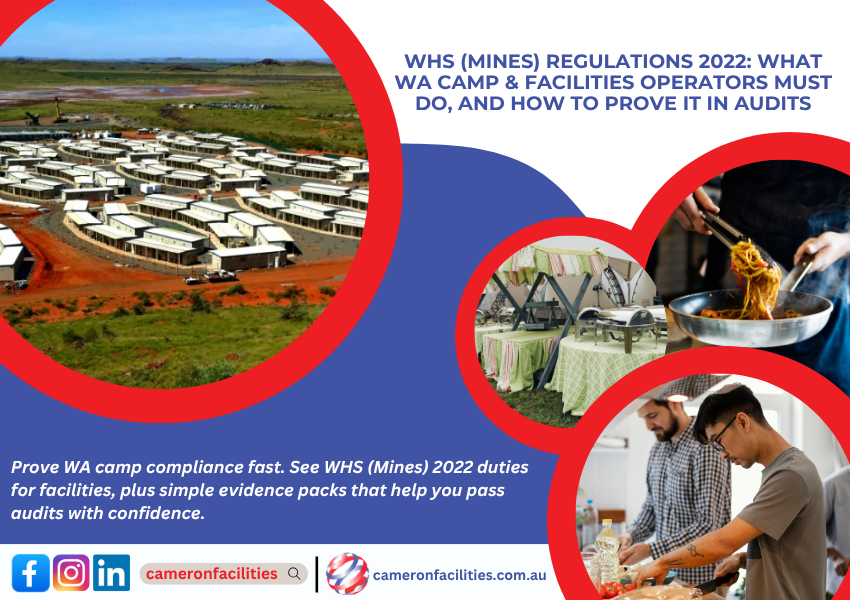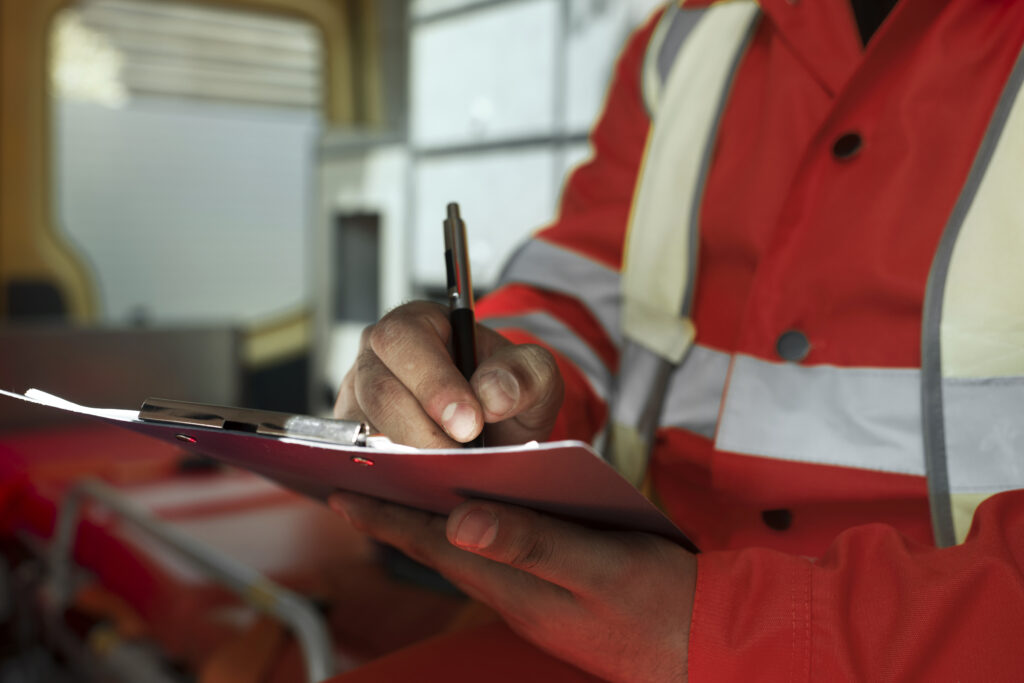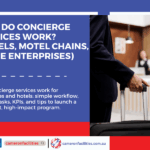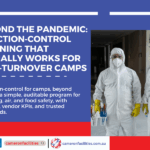
If your FIFO village can’t show clear lines from risk to record, an auditor will spot the gap. The WHS (Mines) Regulations 2022 (WA) set the rules. Camps and facilities support the mine, so the duties reach you, too. This guide explains what the regs expect and how to prove you comply.
“An auditor once told me, ‘If it’s not written down, it didn’t happen.’ That mindset wins audits.”
We keep this simple: what to do, what evidence to keep, and where to find official guidance. You can check the law at the WHS (Mines) Regulations 2022 and the MSMS Code of Practice.
1) Start with the rulebook auditors use: your MSMS (Reg 622)
Your Mine Safety Management System (MSMS) is the backbone. Regulation 622 sets what the MSMS must include. That covers risk management, training and competency, incident response, contractor control, and records.
For camps, make sure the MSMS shows how you manage:
- Accommodation and amenities
- Catering and potable water safety
- Fatigue, alcohol, and other drugs (AOD)
- Emergency planning for villages and after-hours
- Contractor integration (e.g., catering, cleaning, maintenance)
Evidence to prepare
- An MSMS index mapped to each Reg 622 item
- Version control and approvals
- Risk registers, SOPs, and training matrices
Useful links: Content of the MSMS (Reg 622) – information sheet and MSMS overview and resources.
2) Facilities and amenities: the non‑negotiables (Part 3.2)
Part 3.2 sets out general workplace needs. Think toilets, drinking water, washing and eating facilities, first aid and housekeeping. Camps must meet these standards and show that they work every day.
Make it real in camp operations
- Cleaning schedules with sign-off
- Potable water testing and certificates
- Food safety integration with camp kitchen procedures
- First-aid room access after hours; stocked kits; trained first aiders
Evidence to prepare
- Facility registers and inspection logs
- Water test results and corrective actions
- Cleaning checklists and audits
- First-aid stocktakes and training records
Read more in the General workplace management requirements (Part 3.2).
3) Remote and FIFO realities: communication and isolation risks (Reg 48)
Remote or isolated work is common in mining camps. You must manage these risks and provide effective communication systems.
Make it real in camp operations
- Emergency call points and duress systems in common areas
- Sat phone coverage maps and radio procedures
- Night-shift check-ins and lone worker protocols
- Journey management for site-to-camp travel
Evidence to prepare
- Comms test logs and maintenance records
- Check-in rosters and escalation procedures
- Journey management records and close-out notes
See Reg 48 – remote or isolated work and the practical travelling in remote locations guidance.
4) Psychosocial risks, including workers’ accommodation (Reg 55D)
The regs require you to control psychosocial risks. This includes risks that can occur in workers’ accommodation, such as bullying, harassment, fatigue from poor sleep, or unfair access to facilities.
Make it real in camp operations
- Fair room allocation and grievance processes
- Respectful-behaviour policy with clear reporting paths
- Supervisor training to respond early
- Quiet hours and access to rest and recreation
Evidence to prepare
- Psychosocial risk assessment and action plans
- Complaint logs with outcomes and communications
- Toolbox talk records and training attendance
Check Reg 55D – psychosocial risks.
5) Fitness for work: fatigue and AOD (Regs 640–641)
Mine operators must manage fatigue and alcohol, and other drugs. Camps play a big part: rosters, hydration, sleep, and access controls all matter.
Make it real in camp operations
- Fatigue risk management system (FRMS) linked to roster design
- Quiet blocks, blackout blinds, and temperature control for day-sleepers
- Hydration and heat management (ice, water, shade)
- AOD testing program with clear privacy and support steps
Evidence to prepare
- FRMS and roster reviews
- Sleep environment checks and maintenance records
- AOD testing summary reports (de‑identified)
- Incident reviews showing lessons learned
See Regs 640–641 – fitness for work (Emergency and fitness sections are in the official PDF).
6) Emergency planning for camps (Regs 667–669)
Your mine must have an emergency plan. You must keep it on site, provide and maintain resources, and test it at least every 12 months. Camps need clear roles, muster points, and coordination with local services where relevant.
Make it real in camp operations
- Appointed wardens and up‑to‑date evacuation maps in camp buildings
- Cyclone shelters, backup power, and water contingencies
- After‑hours medical response and transport arrangements
- Joint drills with the site and, where needed, DFES/local government
Evidence to prepare
- Drill schedules, attendance, and debriefs
- Equipment inspection records (alarms, extinguishers, radios)
- Emails/records of liaison with emergency services
Read Emergency plan requirements (Regs 667–669) and supporting emergency management guidance.
7) Contractor and catering integration inside the MSMS
Most camp services are delivered by contractors. The MSMS must show how you select, induct, verify, and monitor them. Auditors want to see the links.
Make it real in camp operations
- Pre‑qualification with safety criteria and past performance
- Clear scopes, KPIs, and reporting formats
- Site rules embedded into contractor procedures and inductions
- Joint inspections and close‑out of findings
Evidence to prepare
- Contractor WHS plans mapped to your MSMS
- Induction and competency records
- KPI dashboards and monthly reports
- Audit/finding registers with actions closed out
Use the MSMS Code of Practice and MSMS content information sheet.
8) Make it audit‑ready: the five‑part evidence model
A simple way to pass audits is to bundle proof in five layers:
- Policy/Plan – the rule and intent (e.g., camp hygiene policy)
- Procedure – how staff do it (e.g., cleaning SOP)
- Control in use – what’s happening now (e.g., rostered cleaning, signage)
- Record – proof it happened (e.g., checklist, log, test report)
- Review/Improve – you checked and got better (e.g., audit, action close‑out)
When you file evidence, mirror the regs. For example:
- Keep the emergency plan on site and available.
- Keep the mine record and make it accessible to inspectors.
- Retain relevant WHS management plans and updates.
To check yourself first, use mining self‑assessment templates from WorkSafe WA. Map each finding to a Reg 622 item and assign an owner and due date.
“Show the chain from rule to record. If an auditor can follow it in two clicks, you’re winning.”
Takeaways
The WHS (Mines) Regulations 2022 require camps and facilities to provide safe amenities, effective communication, robust psychosocial controls, fit-for-work systems, and tested emergency plans — all within a live MSMS. Passing the audit is about evidence. Build the five‑part pack, mirror Reg 622, and use WA’s official guides to close gaps fast.
Need help? We can conduct a quick readiness check against your camp operations and provide you with a gap list aligned to Regulation 622. Cameron Facilities provides comprehensive mining camp management services. Contact us today to schedule an appointment with our reliable and friendly facility managers.






